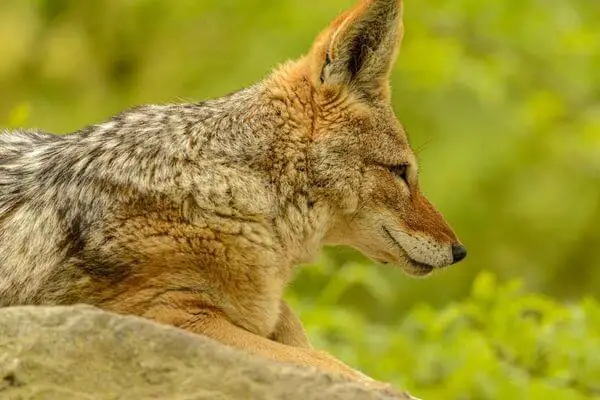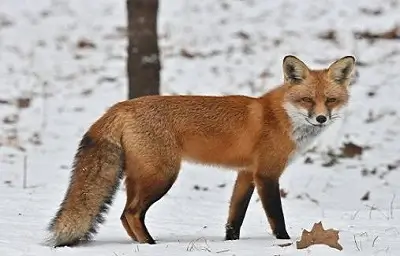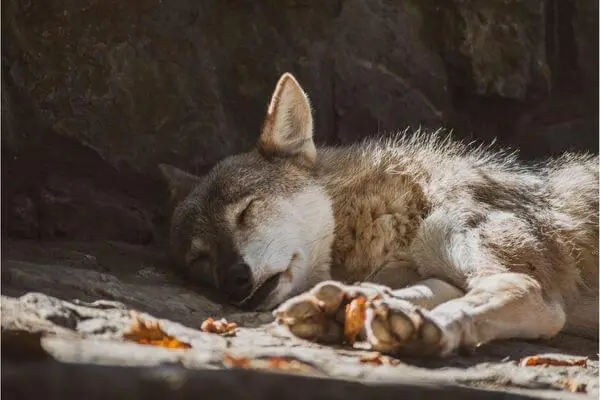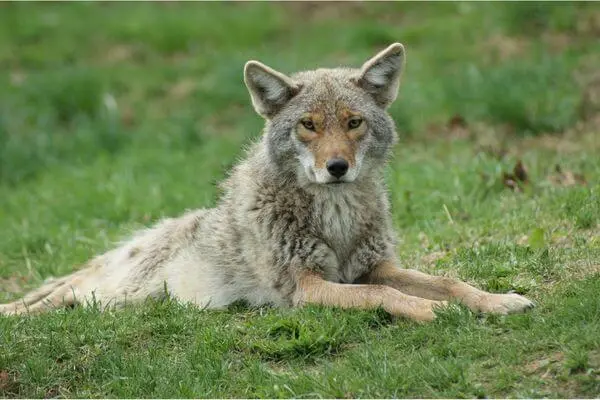Coyotes and foxes are two of the most common wild canids found in North America, both of which are known for their unique characteristics and behaviors. coyote vs fox is topic of great interest for readers of wildlife.
This article helps to learn coyote vs fox, key differences in terms of looks, behavior, habitat, and diet. Distinguish between similar-looking members of the Canidae family.
“The coyote might be the bigger predator, but the fox is the one who outwits them all.”
This quote refers to the idea that while the coyote might be more powerful and physically able, the fox can outsmart its prey and predators, making it a formidable hunter.
While the two animals have some similarities, such as their omnivorous diet and opportunistic hunting tactics, they also have many distinct differences.
Difference between Coyote and Fox
Being a layman having no significant knowledge about wildlife, you might spot wild animals on your picnic spot. If you have an encounter with a coyote or fox, then how will you find the difference between a fox and a coyote? This question matters sometimes.
Coyotes and foxes are both members of the Canidae family, which also includes domestic dogs. It makes sense to expect that fox and coyote might have certain traits in common since they are both biologically related to the same family.
Some confusion still exists about the difference between coyotes and foxes. What are coyotes and foxes look like?
How do Coyotes look like?
Coyote vs Fox: Foxes and coyotes have significance in their size as Coyotes are almost two times big as typical foxes. More grey or brown hues can be seen in the coyote’s fur. It may occasionally appear rusty in hue.

Coyotes’ ears typically have some black fur around the rims, and their underbellies have a lighter shade. Coyotes ‘have wider muzzles as compared to foxes which have thinner muzzles.
Coyotes are typically slim; you won’t find one that is very plump in the wild. They have longer, slenderer legs than foxes have.
How do Foxes look like?
Foxes and coyotes both have very large, pointed ears, while foxes are slightly more pointed. Like cats, most foxes have vertical pupils. The only other canids with vertical pupils are these.
Foxes come in a variety of sizes and forms. Due to their similar coloring, grey fox or coyote may resemble more, yet coyotes are much larger.
Difference in Location Coyote vs Fox
If you are outside North America, then no reason to worry about the difference between fox and coyote because coyote lives just in North America having restricted range.
While fox compared to coyotes has a broader range like North Africa, Asia, Europe, and various parts of North America.
Fox vs Coyote Size
In the comparison of coyote size vs fox, foxes are less than 3 feet in length and width, having shorter legs with the tube-like body.
Coyotes compared to body length is almost more than 3 feet and their height is two feet with significant weight and muscular body.


Coyote vs Fox Tail
Here comes some question regarding coyote vs fox tail. Do coyotes have white-tipped tails? Do all foxes have bushy tails? Do coyotes have bushy tails
Fox tail vs coyote tail could help to differentiate. When compared to its body size, the coyote’s tail is shorter and tends to hang down. It isn’t quite as bushy as the fox tail, either.

Coyotes has always black tip tail. The coyote’s white tip tail has not been seen yet.
When you think of gray fox vs coyote, the gray fox is famous as the long tail fox. A gray fox is a fox with a striped tail. Its tail occasionally ends with a white or black tip.
Red foxes are frequently seen because of their dangling, white-tipped tails. Despite its smaller size compared to coyotes, the fox has a longer and bushier tail. There is no fox without a bushy tail.
Coyotes vs Foxes: Color Description
When you compare foxes and coyotes, the coyotes have usually various shades of gray in their coat and some coyotes can be red.
While in contrast, the coat colors of foxes vary according to species. The usual coat colors of a fox are gray, yellowish brown, silver, and red. You might think that the rusty red coat color of the red fox makes it easy to recognize, but you should remember that this species also has several distinct color morphs, including grey, silver, and blackish-brown.
The gray color variation in red foxes and similarity with gray foxes, although gray fox is a distinct specie from the red foxes, are most likely to be mistaken for coyotes.
In similar coloring, grey foxes may resemble coyotes, although if you compare gray foxes vs coyotes, then coyotes are much larger.
Foxes vs Coyote: Feeding Habits
Foxes frequently consume Small prey, including mice, moles, rats, voles, and rabbits. They may occasionally prey on young kittens, but this is not their preferred food source.
The same kind of animals that foxes eat, can also be consumed by coyotes, although coyotes like to pursue larger prey such as small dogs, deer, and livestock. Coyotes are considered a detrimental pest by farmers and ranchers because they may and will prey on cattle.
Coyote and Fox Differences on Basis of Sound
Foxes and coyotes have completely dissimilar vocalizations, which can be used to tell the two animals apart.
In a comparison of coyote vs fox sounds among all wild canines, coyotes are among the loudest. They can be recognized by their protracted, wolf-like howls that rise and fall in pitch and are occasionally accompanied by yips, yelps, and barks.
The fox, in comparison, does make some howling noises, but its high-pitched whining or yelping sound makes it the easiest to spot. They don’t sound much like a wolf or dog.
Coyote and Fox Differences on Basis of Living Style and Social Behavior
Fox or coyote differences can be understood by their living style. While not quite as sociable and gregarious as the wolf, the coyote is nevertheless a pack animal that cohabitates with several other members of its own family. Occasionally coyotes live even with other animals who are not their family.
The coyote will only deliberately use a den during mating season. If not, they slumber and relax above the earth. Generally, coyotes are much more social than foxes.

During the day, coyotes frequently hide in elevated locations or exposed covered areas. They can adapt an old den made by another species, such as raccoons, into their new home. They build their dens in hollowed-out tree stumps or rock outcrops.
Coyotes sleep above ground in forests and mountains in packs. They may live in cities and even in neighborhoods
In contrast, the fox lives alone outside of the breeding season and occasionally divides its territory with other members of its close family. It resides in a den or burrow that has a network of tunnels and specific chambers. Commonly you will not see a group of foxes running and playing in a group or pack.
Foxes live underground in tunnels called dens, which they have carved out of the dirt. The tunnels that connect these burrows enable the fox to travel from one to the other while remaining underneath.
Foxes not only store their food in these dens, but they also use them to sleep. Along with grasslands, deserts, and mountains, foxes also live in forested environments.
Coyotes and Foxes have a Territory Dispute
Coyotes and foxes both have dens. Under enormous stones and in locations where they can dig down far, they build their dens. They can be found near civilization and are quite adaptable. For homeowners who are concerned about their pets being outside at night, this can be a hassle.
Foxes have dens as well, and frequently the two species’ ranges will overlap. Conflicts over territory may develop as a result of this. Both animals fox versus coyote leaves urine marks on their dens and home ranges.
Both animals have smell glands in their paws, which they use to touch rocks and the ground to spread their fragrance. As a result, scent and visual traces are left behind, alerting nearby animals to the presence of the visitor.
Once the puppies are born, coyotes abandon their dens. While the pups are being nurtured, the males stay away from the dens and them. It may lower their chance of survival.
Baby Coyote vs Baby Fox
A young fox and a young coyote look like a jackal If you’ve ever seen a jackal in person or even in a photograph. You know that small or coyote foxes resemble Jackals. Although jackal is not a result of the mating of these two species and is not either a fox or a coyote.
Jackals and coyotes are close relatives in the canine genus. Coyotes reside in North and Central America, but jackals are found all across the old world.
Let’s unfold some more facts
- Foxes
Foxes have a gestation period of 52 days. Within the first three weeks after birth, the puppies are kept in the den while being fed.
They begin to emerge from the den during the fourth week while still being closely watched by their mom.
After six months, they become young foxes and can start looking for partners and living on their own.
- Coyotes
Coyotes have a 60-day gestation cycle and mate in the middle of January to February.
The mother gives birth to 2 to 10 pups, some of which may live for up to 7 weeks without their mothers. The small coyote can go hunting with their mothers at around 7 months old.
Fox Poop vs Cat Poop
Coyote poop vs fox poop typically differ in size but have a similar appearance. Fox poop, also known as excrement, is typically two inches long, although coyote scat can reach a length of four inches. Both animals’ poops might appear white and contain animal hairs.
You can find berries, hair, bones, and more in their excrement because they both eat a lot of the same foods and have extremely similar diets. Both creatures’ droppings have pointed twisted ends. This comes from the fur of the creatures they consume. Encasing sharp bones in fur, which prevents internal punctures, can aid in their digestion.
Can Foxes and Coyotes Breed
There may be a weird question can coyotes breed with foxes?
The answer is very much simple that is “Yes”. Coyotes and foxes can breed and produce hybrid offspring, although the resulting hybrid, known as a coyfox, is relatively rare. Hybridization between coyotes and foxes is most likely to occur when the ranges of the two species overlap, such as in urban or suburban areas.
The coyote and red fox are both members of the canidae family, and they are closely related enough to be able to produce fertile offspring. However, the likelihood of successful breeding and the survival of hybrid offspring in the wild is generally low.
This is because coyotes and foxes have evolved to occupy different ecological niches and have different behaviors and adaptations that allow them to survive in those niches.
It’s worth noting that hybridization is a natural phenomenon that can happen in the wild, but it’s not common and hybridization is not always fertile, some will not be able to reproduce.
Comparison of a coyote with some other species of its family:
| Coyotes vs | Wolf |
| Coyotes weigh around 20-40 pounds and stand around 2 feet tall at the shoulder. | Wolves are much larger than coyotes, with adult wolves typically weighing between 60-100 pounds and standing up to 3 feet tall at the shoulder. |
| Florida coyote vs | Maryland coyote |
| Florida coyotes can be found in a wide range of habitats, including wetlands, forests, and even urban areas. | Maryland coyotes are found primarily in wooded areas and rural farmland. |
| New jersey coyote vs | Texas fox |
| New Jersey Coyotes are generally larger than foxes and have a more slender build. Coyotes have distinctive bushy tails and pointed snouts. | Taxes foxes, on the other hand, have a more rounded snout and a fluffy tail. |
| Pennsylvania coyote vs | California Fox |
| Coyotes are generally larger than foxes and have a more robust build. Adult coyotes in Pennsylvania can weigh between 15 and 40 pounds. Coyotes are more agile and have more endurance than foxes too, they also have bigger feet and long legs. | While adult Foxes in the same region typically weigh between 8 and 15 pounds |
Conclusion
In short, coyotes and foxes are both members of the Canidae family, but they are distinct in terms of size, appearance, habitat, and behavior. Coyotes are generally larger than foxes, with an adult coyote weighing around 25-35 lbs, while an adult fox weighs around 8-15 lbs.
Coyotes have a more grayish, scruffy look and a more pointed snout, thicker tail, and longer legs, compare to the red fox which has a sleek, reddish-orange coat, narrow and expressive face, and taller and more pointed ears.
Coyotes are found in a variety of environments including deserts, prairies, and forests, while foxes are generally found in more rural or suburban environments. Coyotes are known for their vocalizations, which include howls, barks, and yips, while foxes are generally silent.
They are both interesting and unique animals that have different adaptations to survive in their respective environments.

